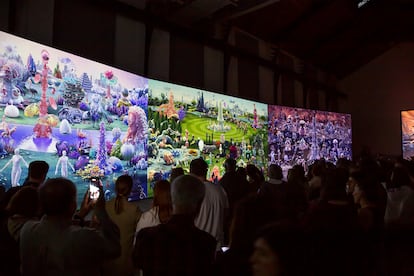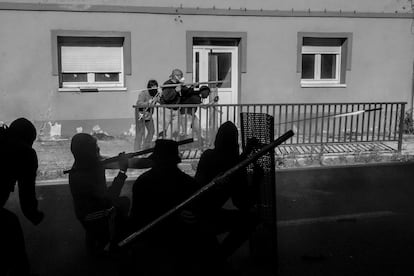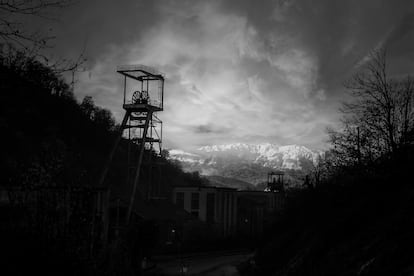Two Castilletes rise in the narrow Valley of Turón, Council of Mieres, Asturias, between the river and the road, encased in the thick mountains of Castaños. It is the Santa Barbara well, which is anniversary: 30 years ago, in 1995, coal extraction stopped here. There has been no industrial noises for a long time: only the wind that blows through the branches, the water that runs in the river, some car that passes, not many.
The exploitation had begun in 1913, always linked to the Basque industrialists who allocated coal to the steel. Here was removed and 115 miners died here. After the closure, in 2008, he was declared a Cultural Interest (BIC). “Now and in the future we have to recognize ourselves in the workers who preceded us: we are debtors of the miners,” says María Fernanda Fernández. Since 2021 it is an artistic interventions center, the PZSB, commissioned by Lev (Visual Electronics Laboratory): the intervention has just closed Speculumof the Smack collective, a recreation in video art of The Garden of Delights of El Bosco.
The adventure of the Santa Barbara well is illustrative of the future of the Asturian mining basins: of Economy of the Economy, Industrial Pole of Spain, cradle of the labor movement, motive of identity and pride, to the need to recycle before an uncertain future using the available tools: the valuable heritage heritage, historical and cultural. And tourism, vigorized by the questionable idea that they exist climatic shelters and that Asturias is one of them. Mining is gone, but somehow, it is still there. There is pride in the inheritance received, but also a feeling of uncertainty, of final defeat, of failure due to poorly managed deindustrialization that did not find a light at the end of the tunnel.
“We are the first generation in 150 years that does not have a life directly linked to mining and, at the same time, we are the last one that we could see with our own eyes,” says the writer and journalist Aitana Castaño, who grew surrounded by mines and miners, also of strikes and barricades. In his books he tries to maintain the flame for the new generations: the trilogy formed by Carboneras, Smoke children y Ash traces (Silver fish), where, with illustrations by Alfonso Zapico, remember different aspects of the mining industry, such as the perspectives of children or women. They are read in the Institutes of the Basins, so the Guajes They recognize it on the street.
The coal, since the mid -nineteenth century, brought the railroad, steel, ports and shipyards and a large subsidiary industry. But the mineral that awaited in the depths also became a pillar of the identity of the basins and, therefore, of the region: the mother rock of its sentimental geography. “Everything leaves the mine,” it said. Now nothing comes out, but much remains. “The character or mining condition of these spaces and their inhabitants endures and this despite the fact that wells of wells have become uninterrupted since the nineties,” writes historian Irene Díaz in the recent book The Mining Basins of Asturias: The crisis and their narratives (Trea).
There is a physical persistence, in the form of Castilletes, buildings or dumps, but also intangible traces that refer to the experience lived. A “distant closeness”, in the words of Díaz, that “allows you to approach the consequences and legacies in the people, communities and spaces of that process of Industrial Ruinification“. A Ultra lifeas the historian calls her, also co -director, along with Rubén Vega, of the documentary Cultural memories of an industrial past. The definitive closure, with some exception, occurred in 2018. The death in April of five miners in the Zarréu well, with investigation permission, recalled that some were still there, horanting the earth. Grisú again.

As for physical persistence, part of the valuable industrial heritage is now used for tourist and cultural purposes, not only the Santa Barbara well, but also the mining ecomuseum of Samuño, in Langreo, or the Soton well, in the delivery, which can be lowered, dressed in monkey, helmet and lamp, in a demanding five -hour visit, more than 500 meters deep. The Siderurgy Museum (Musi) is welcomed today by an old industry of the bouquet in La Felguera and the Mining and the Asturias Industry Museum (MMI) is located in a dump in the San Vicente mine, in the delivery. Thus, economic activity became a museum. Or in something else: it is investigated how to allocate the wells to underground greenhouses or computer server centers. There is a lot of space in that horated subsoil.
Vacuum sensation
The mining decline is collected in Minada Asturiasthe photographic project of Álvaro Fuente, which began to be interested in 2012, on the occasion of a report on the centenary of the Mining Rescue Brigade. The photographer recalls the “sensation of vacuum” and the hardness the first time he went down to the famous Pozo María Luisa, also the feeling of solidarity that escapes the underground and permeates the culture of the basins. “In the mine you depend on the partner and the problems have to be left out. From the beginning that connection fascinated me … to the point of swarming each other, a gesture that seemed very expressive to me of companionship,” he says. Perhaps that connection was what made a society that attracted thousands of people from many places in Spain and Portugal in a very short time; Because the basins are pure Asturias, but not so many have four Asturian grandparents.

In the fountain photos the depth of the galleries is seen, but also the struggles on the surface. That year, 2012, it was very conflictive: a walking on Madrid, road cuts, riots, slopes, loads and races: the miners were always a hard bone to gnaw for the police forces (we are talking about people who worked underground with heavy tool and explosives), and they were also then, when the next closure of mining was announced, a process that Marcos also recounts M. Merino in the movie Reminon, the last labor movement.
Strike and revolution
But the revolution of 34 is the culmen of the Asturian mining epic, above other milestones such as the 1917 strike or those of the 60s. To that historic milest The northern ballad (Astiberri), by Alfonso Zapico. The civil war in Asturias is treated in the Republican trilogya series of movies and Expanded scripts (in book format, published by silver fish) by Ramón Lluis Bando. Very specifically Songs for a revolutiona musical documentary in which the memory of 34 is recovered through his songs, with the musician Nacho Vegas. A reminiscence of struggles and revolutions is also the concept of resistance box: thus, resistance box, names the City Council of Mieres to its cycle dedicated to cultural expressions censored in municipalities on the right: creators such as Pedro Pastor, Rocío Saiz, Paco Becerra, Alberto Conejero or Bob Pop. of culture … and exminera.

There are mining strokes in contemporary music as disparate as the missing industrial group Fasenuova or artist María Valle Ros Cold tomorrow). Literature entered the depths at least from the classic The lost villageby Armando Palacio Valdés, which, published in 1903, recounts with duel the transformation of the rural world into industrial, of the Asturias Verde to the black and red Asturias, with the arrival of the mine. But that continuous tradition, as seen in The Blue Palace of Belgian Engineers (Cliff), by Fulgencio Argüelles, a precious, tender book, almost worship, set in the 20s.
There are other optics: in How is the mountain to be a god (Pumpkin Pepitas), Eduardo Romero traces with intelligence nothing common with Latin America and the phenomenon of migrations, before and now, both ways. Romero points out the possibility of memory “Without doing apology for industrialism, developmentalism and extractivism. There is no contradiction in unraveling the destructive dynamics of fossilist capitalism while rescuing the memory of those who played their lives down to the well and started labor and social rights to the patterns and the state. If we managed to depatiate that memory, the task will be complete”.
And there were not only mines in Asturias: in Children of coal (Alfaguara) The Leonese Noemí Sabugal gives a great panoramic view, mixing her memories of mining family with a trip through different places of extraction from Spain: also Galicia, León, Palencia, Córdoba, Teruel.

“Around the mine, a collective conscience and a way of seeing the world was created; also, to another level, a certain confidence in the future and a tremendous respect for culture. It is not strange that mining areas are prone to art: we have been pissed off several decades, disenchanted, forced to emigrate …”, says the poet Langrean A European peace (Pretext) the The socialist family (The beautiful Warsaw) are crossed by the experience of growing in the basins. “In a way, the basins are an intuition of the future for many territories in Europe,” he adds. An uncertain future: for the basins … and for the whole world.
“It is likely that the mining identity will be diluted,” concludes Aitana Castaño, “but it is our obligation to last. The mines came thousands of people to break their horns to work and make their families live better … Even if only by honor of those people we have no other than defending the mining identity. And, as the Benigno delmiro philologist says, literature, the culture, the culture that is not closed.”

